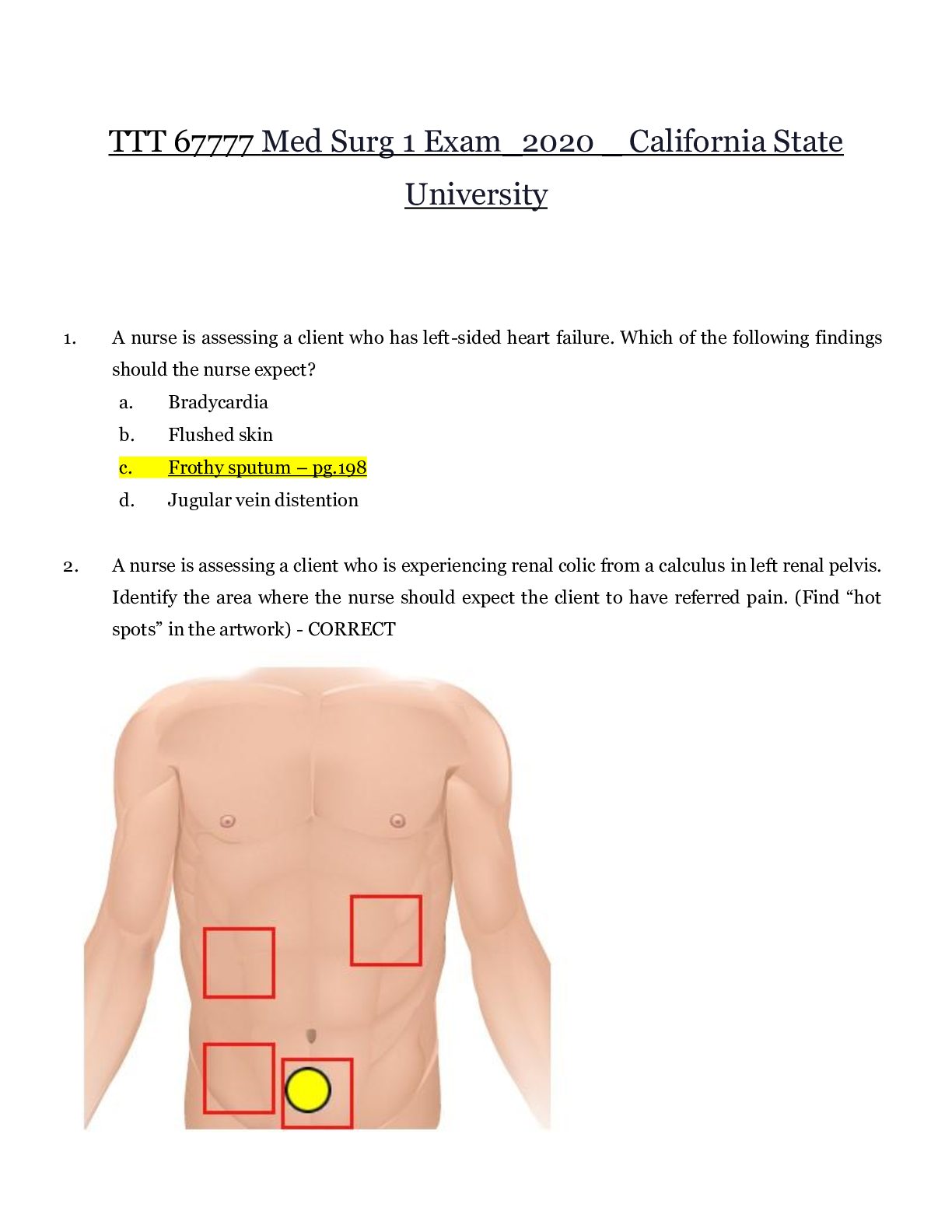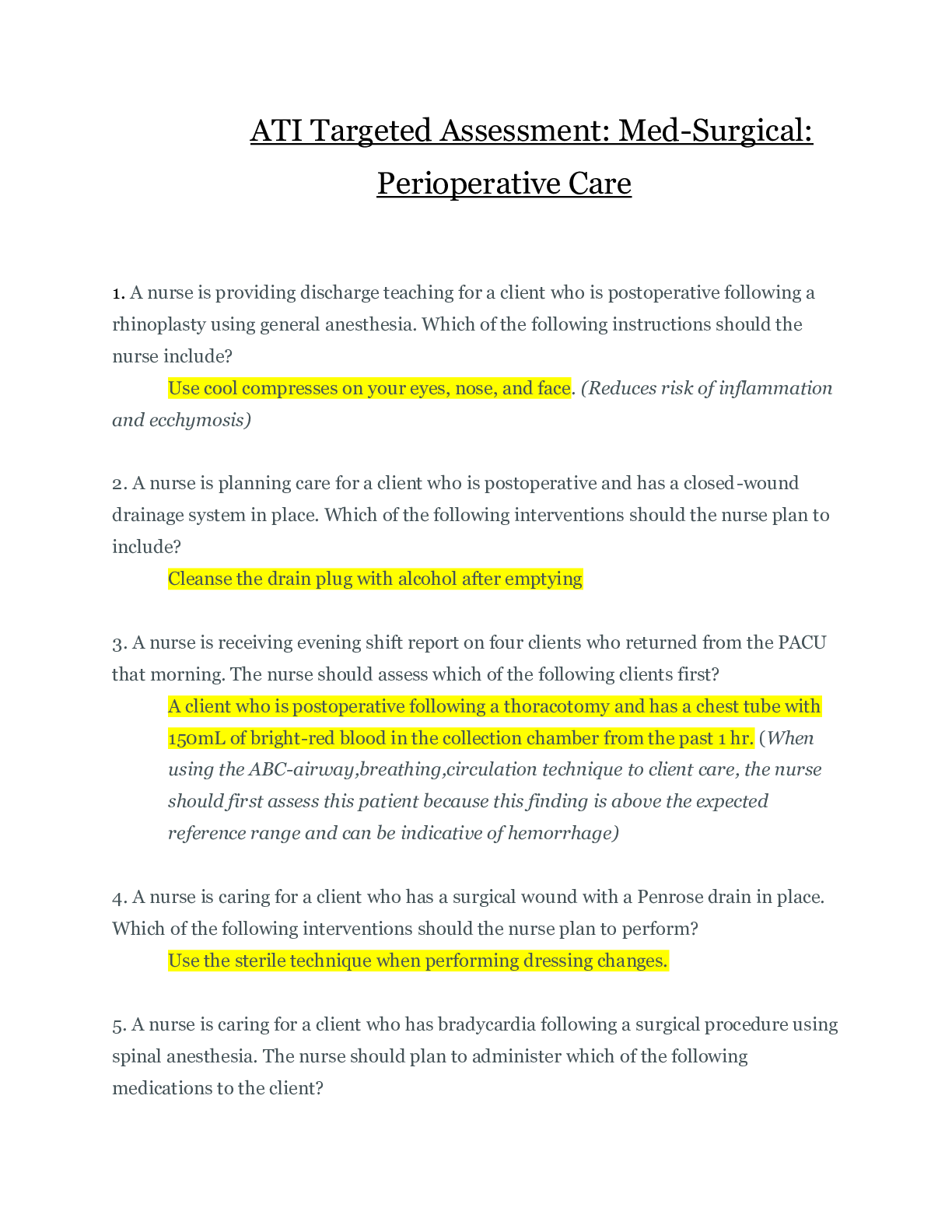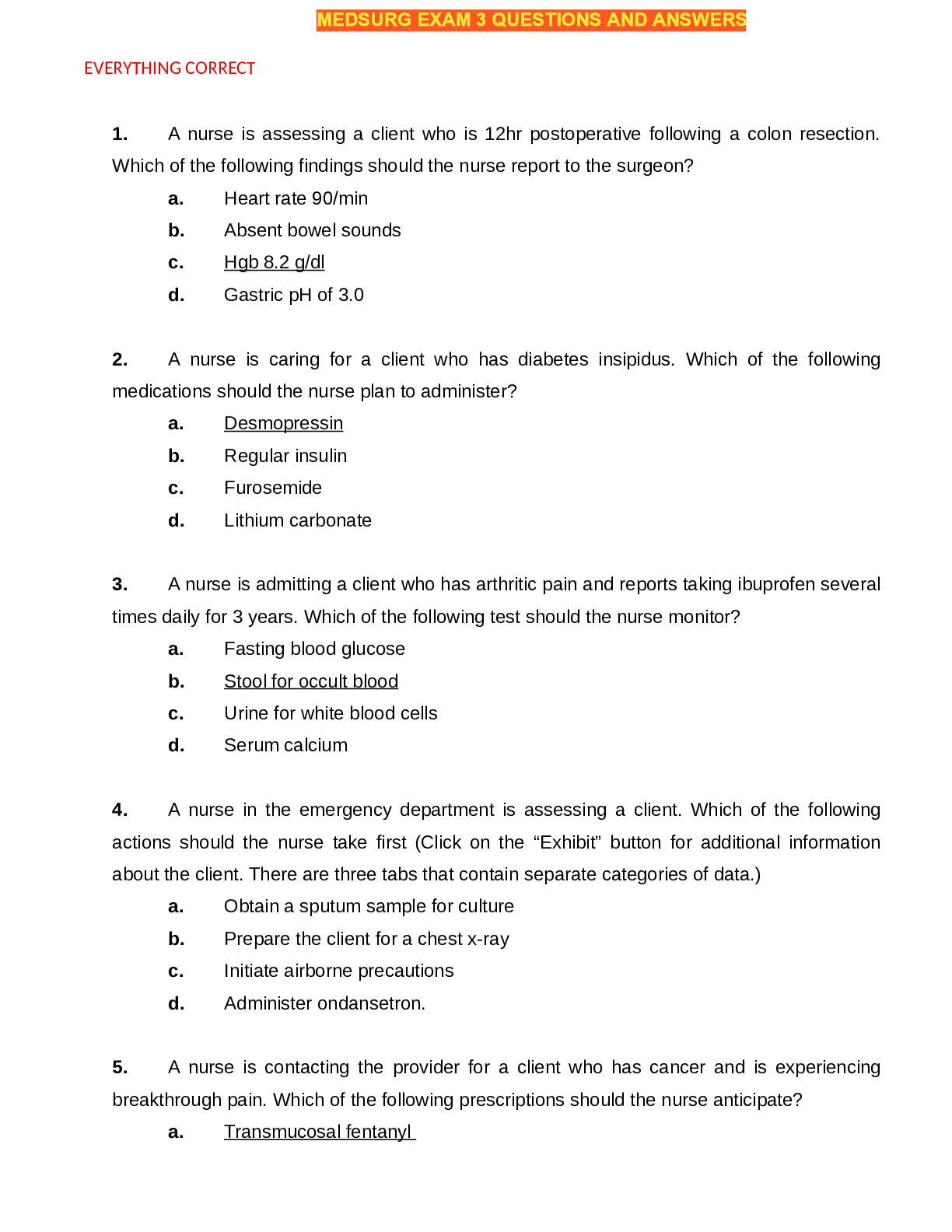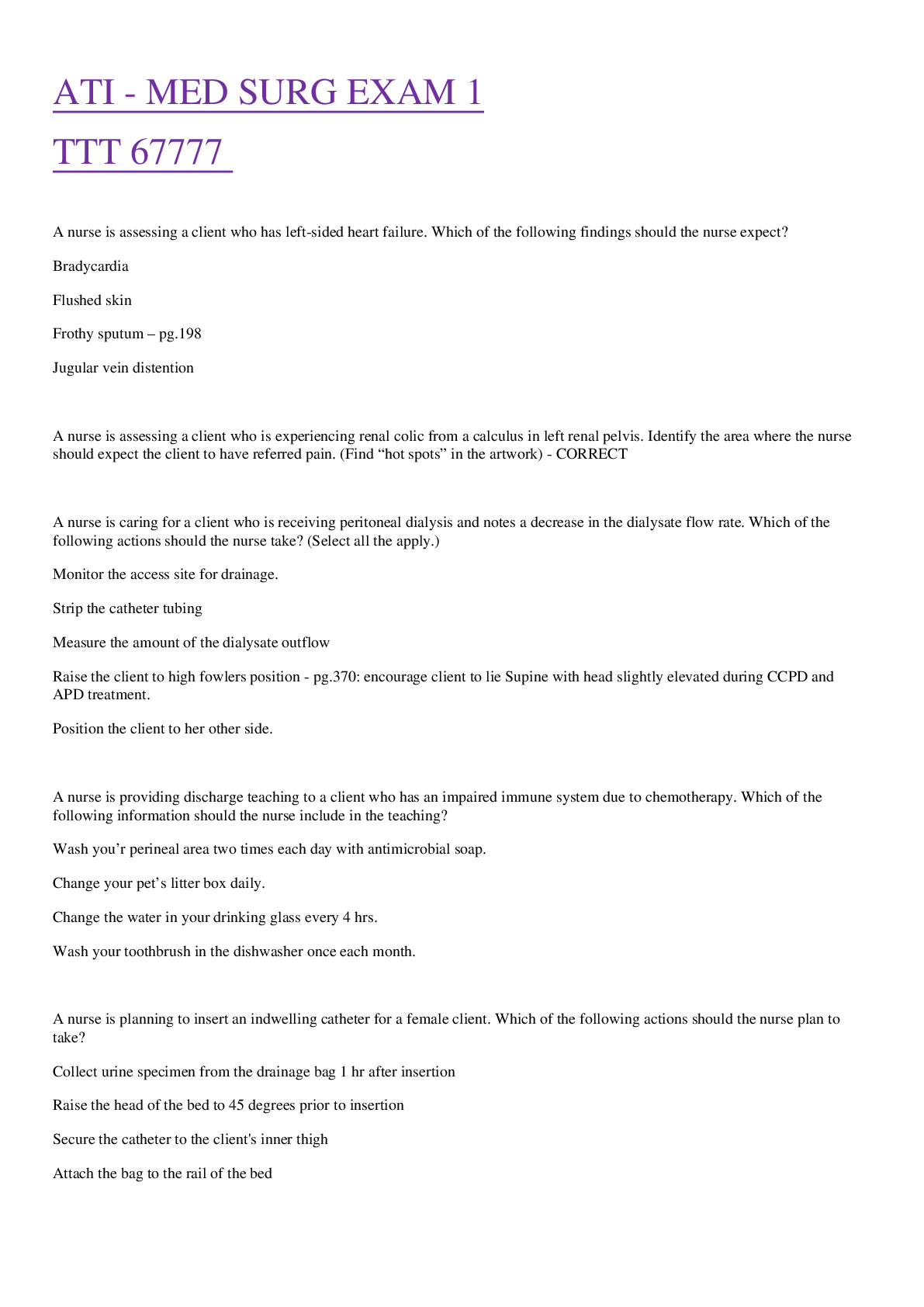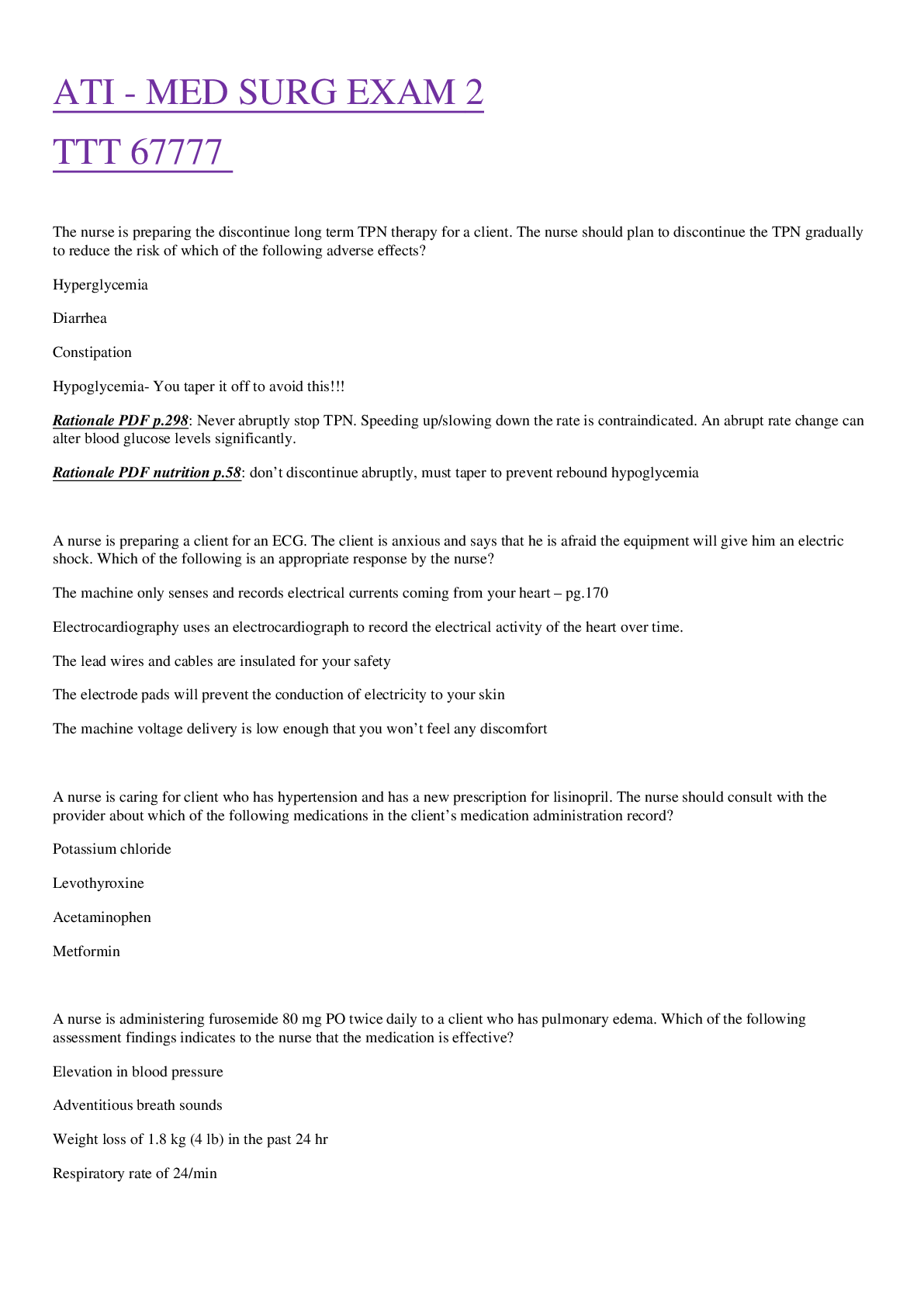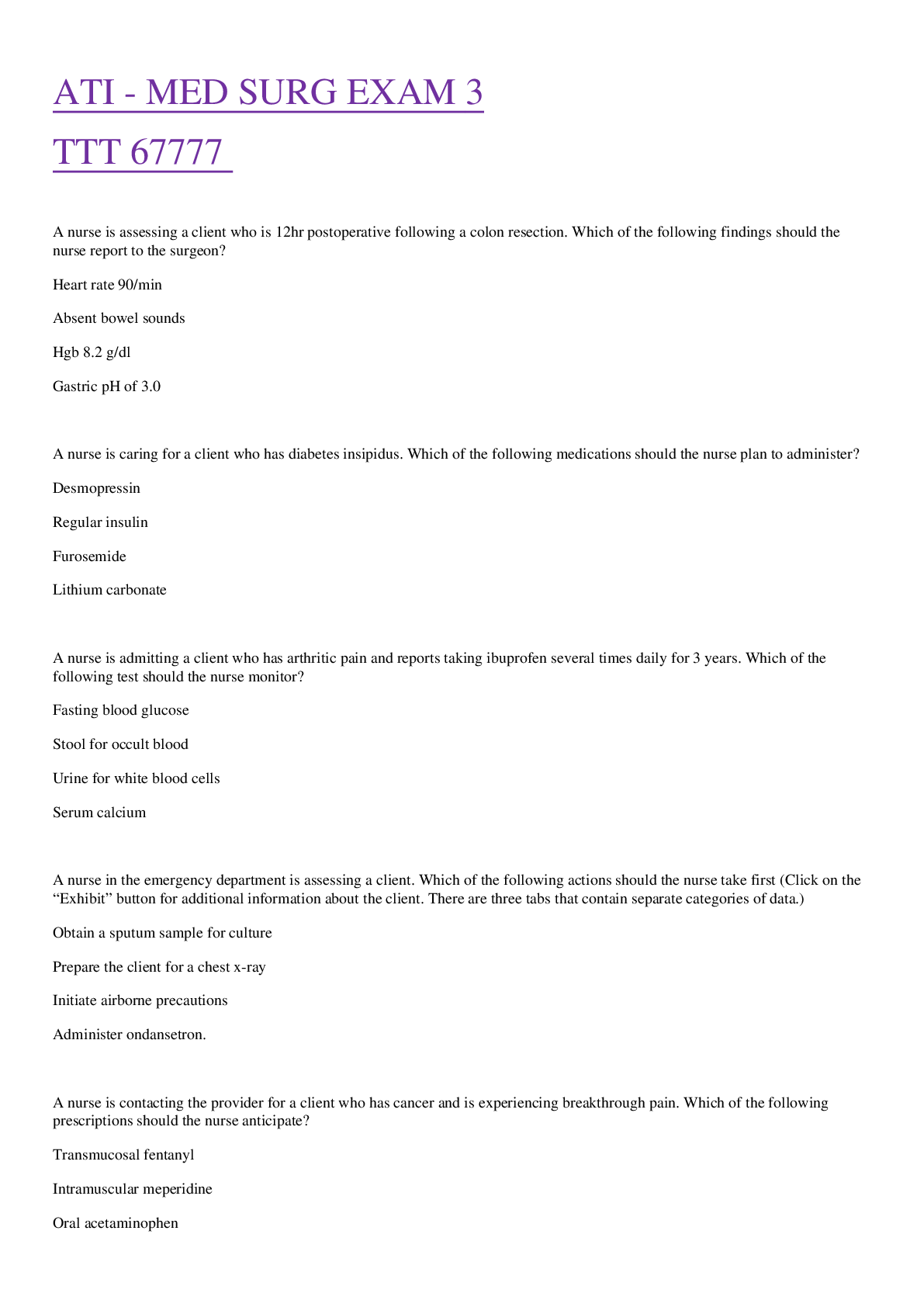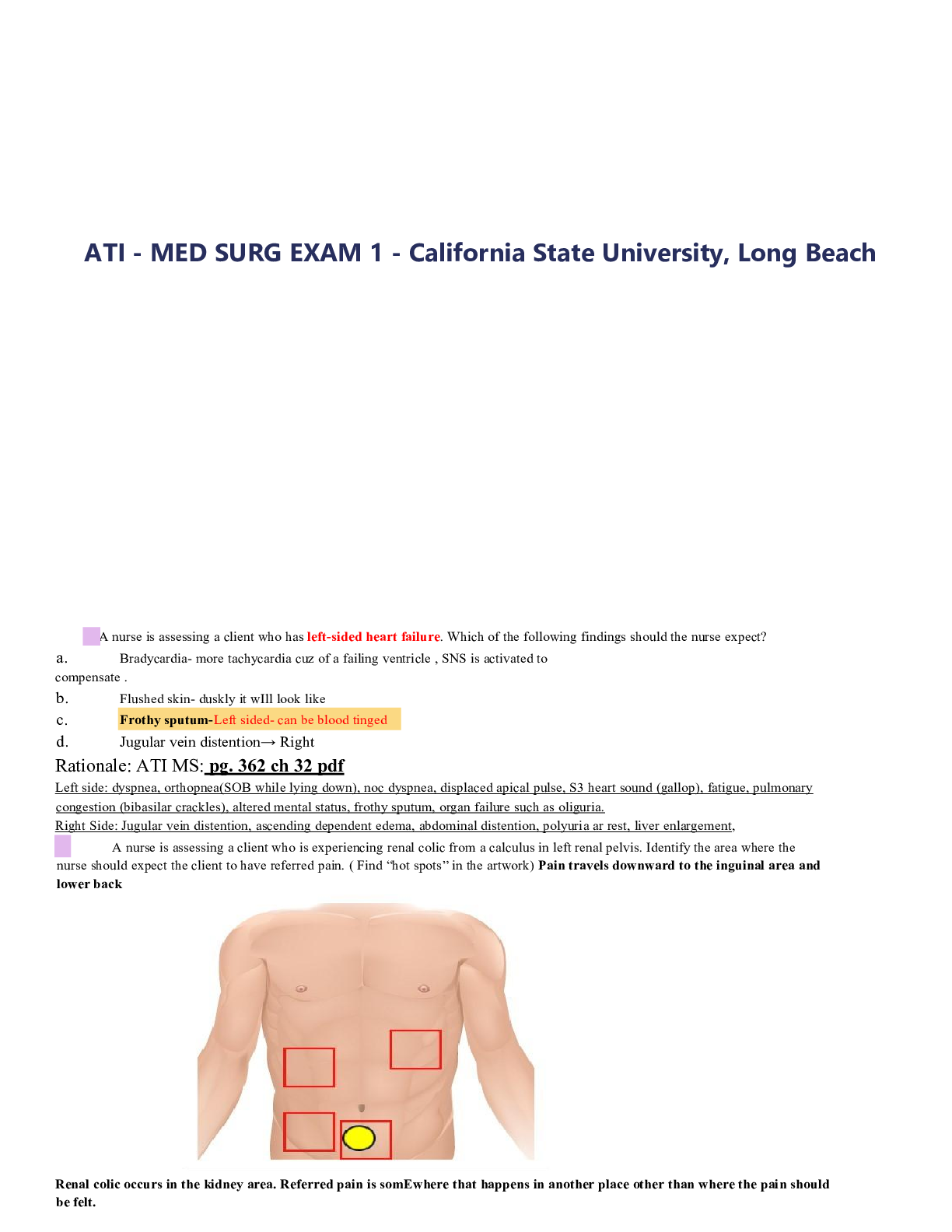*NURSING > ATI MEDICAL SURGICAL > TTT 67777 Peds-II-trans Exam_2020 _ California State University | TTT67777 Peds-II-trans Exam_2020 (All)
TTT 67777 Peds-II-trans Exam_2020 _ California State University | TTT67777 Peds-II-trans Exam_2020
Document Content and Description Below
TTT 67777 Peds-II-trans Exam_2020 _ California State University PEDS VERSION 2 1.A nurse is reviewing the laboratory report of a toddler who has hemolytic uremic syndrome. Which of the followin... g findings should the nurse expect? 1. Urine casts absent 2. BUN 28 mg/dL 3. Hgb 18 g/dL 4. Creatinine 0.3 mg/dL HUS is an acute renal disease characterized by ● Acute renal failure,hemolytic anemia and thrombocytopenia. ● Main causes of acute renal failure in early childhood. Breakdown of red blood cells clog the kidneys. ○ Dec Hgb and Hct, Elevated reticulocyte, Hematuria, Proteinuria, Elevated BUN and creatinine, Fibrin split products in serum and urine (thrombocytopenia). 2.A nurse is caring for a preschool-age child who is postoperative following a tonsillectomy and is clearing her throat frequently. Which of the following actions should the nurse take first? 1. Offer the child an ice collar 2. Give the child small sips of water 3. Administer an analgesic 4. Observe the child’s throat with a flashlight- assessment ● Assess for evidence of bleeding, which includes frequent swallowing, clearing the throat, restlessness, bright red emesis, tachycardia, and/orpallor. 3.A nurse is teaching a parent of a 10-month-old infant about home safety.Which of the following instructions should the nurse include in the teaching? (SELECT ALL THAT APPLY) 1. Remove labels from containers that contain toxic substances[1] 2. Place gates at the top and bottom of the stairs 3. Ensure the crib mattress is in the lowest position 4. Keep toilet lids in the upright position 5. Select a toy chest that has a heavy, hinged lid- i’m not sure on this one possibly since they’re at risk for suffocating/choking on small toys? Okie...i go with you We gonna kill our babies 4.A nurse is providing teaching to the parent of a school-age child who has diabetes mellitus about managing diabetes during illness.Which of the following statements by the parent indicates an understanding of the teaching? 1. “I will monitor my child’s blood glucose levels every 8 hours.” (3 hours) 2. “I will increase the amount of fluids I offer my child.” 3. “I will offer my child 20 grams of carbohydrates every 2 hours.” 4. “I will withhold my child’s dose of insulin when his appetite is poor.” 5. A nurse is assessing a 6-month-old infant who has respiratory syncytial virus. The nurse should immediately report which of the following findings to the provider? 1. Coughing 2. Tachypnea- manifestation in severe illness as disease progresses 3. Rhinorrhea 4. Pharyngitis RSV - very common virus that leads to mild, cold-like symptoms. Virus spreads through tiny droplets that go into the air when a sick person blows their nose, coughs, or sneezes. ● Cyanosis(more severe cases), labored breathing, nasal flaring, RAPID BREATHING(TACHYPNEA), SOB, wheezing 6. MISSING 7.A nurse is providing education about dietary modifications to the parents of a school-age child who has glomerulonephritis. Which of the following information should the nurse include in the teaching? 1. Increase the child’s calcium intake 2. Increase the child’s intake of carbohydrates 3. Decrease the child’s fat intake 4. Decrease the child’s sodium intake Glomerulonephritis - inflammation of the tiny filters in your kidneys. Possible restriction of sodium and fluid 8. A nurse is providing discharge teaching to the parents of a toddler who has iron deficiency anemia and a new prescription for ferrous sulfate elixir.Which of the following instructions should the nurse include? 1. “Stop this medication if your child’s stools are a tarry green color.” (Expected for adequate dose) 2. “Give your child this medication with a glass of milk.” (1 hr before or 2 hr after milk to prevent dec absorption) 3. “Don’t allow your child to have orange juice while taking this medication.” (Vitamin C inc absorption) 4. “Administer this medication to your child with a dropper.” (Administer through straw to prevent staining teeth so I guess this one?) 9.A nurse is admitting a child who has pertussis. Which of the following transmission-based precautions should the nurse initiate? 1. Protective 2. Droplet 3. Airborne 4. Contact 10. A nurse is caring for a preschooler who has a brain tumor. Which of the following findings is the priority for the nurse to report to the provider? 1. Hyperactivity 2. Pruritus 3. Diplopia 4. Nightmares Vision changes 11.A nurse is caring for a school-age child who is experiencing a sickle cell crisis. Which of the following actions should the nurse take? 1. Administer furosemide IV twice per day (IV fluids for electrolyte replacements, blood products, pain meds, or abx) 2. Decrease the child’s fluid intake (maintain fluids) 3. Initiate contact precautions 4. Apply warm compresses to the affected areas (comfort measure -warm packs to painful joints) SCC- exacerbation of sickle cell anemia - RBC sickling leading to increased blood viscosity, obstruction of blood flow, and tissue hypoxia 12. A nurse is providing anticipatory guidance to a parent of a 1-month old infant. The nurse should include that it is recommended to start the series of which of the following immunizations first? 1. MMR (12-15 mo) 2. Hep A (12 mo - 2 yr) 3. Varicella (12-15 mo) 4. Inactivated poliovirus(2 mo) Hib, PCV, IPV, - all begin at 2 months ● diphtheria and tetanus toxoids and pertussis (DTaP) ● rotavirus vaccine (RV) ● Inactivated poliovirus(IPV) ● Haemophilus influenzae type B (Hib) ● pneumococcal vaccine (PCV) ● Hep B 13.A nurse is providing discharge teaching to the parents of an infant who is at risk for SIDS.Which of the following statements by the parents indicates an understanding of the teaching? 1. “I will move my baby’s stuffed animal to the corner of her crib while she sleeps.” (Toys kept out of reach) 2. “I will have my baby sleep next to me in bed during the night.” (roll over in your sleep = crushed baby) 3. “I will dress my baby in lightweight clothing to sleep.” (Prevent overheating) 4. “I will lay my baby on her side to sleep for naps.” (On back) 14. A nurse is prioritizingcare for four clients. Which of the following clients should the nurse assess first? 1. An adolescent who is in skin traction and reports a pain level of 7 on a scale from 0 to 10 2. A toddler who has a partial-thickness burn on his right hand and requires a dressing change 3. A toddler who has a new diagnosis of osteomyelitis and is to receive an IV bolus of nafcillin 4. An adolescent who has sickle cell anemia and slurred speech- complication: CVA 15. A nurse is planning care for an adolescent following repair of Meckel diverticulum. Which of the following actions should the nurse include in the plan of care? 1. Administer TPN 2. Initiate long term antibiotic therapy 3. Maintain an NG tube for decompression- ATI says “maintain NGT to low continuous suction” 4. Teach the client about ostomy care Decompression - removing stomach contents Meckel’s diverticulum - complication resulting from failure of the omphalomesenteric duct to fuse during embryonic development 16. A nurse is providing teaching to the parents of a preschool-age child who has celiac disease. Which of the following instructions should the nurse include? 1. “Your child will need to follow a low-protein diet temporarily.” 2. “You should place your child on a high-fiber diet when she has an exacerbation.” 3. “You should replace white flour with wheat flour when preparing meals for your child.” 4. “Your child will be on a gluten-free diet for the rest of her life.” 17. A nurse is caring for a child who has acute glomerulonephritis.Which of the following findings should the nurse expect? 1. Temperature 39 ℃ (102.2℉) 2. Periorbital edema Facial edema that is worse in the morning but then spreads to extremities and abdomen with progression of the day 3. Positive urine culture (proteinuria, smoky or tea‑colored urine, hematuria, increased specific gravity) 4. Hypotension (HTN) ATI 157 18. A nurse is caring for a single mother of a 6-month old infant. During a well-baby visit, the mother expresses feeling “inexperienced” in caring for the baby.The nurse should recommend which of the following community resources? 1. Support group for postpartum depression 2. Parent management training 3. Respite child care 4. Parent enhancement center (prevent child abuse) I can't find these skimming through the book so I'm guessing haha that’s what i was gonna put 19. A nurse is providing postoperative care for a child following an arterial cardiac catheterization. Which of the following actions should the nurse take? 1. Keep the affected extremity straight for at least 6 hr(4-8 hr& lower HOB) (prevents bleeding) 2. Remove the child’s pressure dressing after the first 4 hr (maintain clean dressing)(day after proced) 3. Maintain the child’s NPO status for 4-6 hr (pre-op) 4. Monitor output using an indwelling urinary catheter for the first 24 hr (monitor I&O to assess for adequate UO) 20.A nurse is reviewing the medical record of a 24 month old childwho has acute lymphocytic leukemia. Which of the following actions should the nurse take? (EXHIBIT) 1. Initiate bleeding precautions- platelets is low (normal 250k-450k) wait isn’t it 150-450k? 2. Apply viscous lidocaine to the oral mucosa 3. Obtain a rectal temperature every 4 hr - noooo - risk for bleeding 4. Place the child in knee-chest position - inc O2 to body tissues, but RR is normal 21. A nurse is teaching an adolescent how to manage his cystic fibrosis. Which of the following statements by the adolescents indicates an understanding of the teaching? 1. “I will limit my calcium intake to prevent kidney stones.” 2. “I will increase my intake of vitamin D.”- needs vitamin ADEK 3. “I will be excused from physical education class.” physical exercise helps with mucus expectoration and effective breathing pattern 4. “I will take fewer enzymes when i eat high-fat foods.” - additional enzymes are needed if consuming high-fat foods CF: respiratory disorder - mucus glands secrete an increase in the quantity of thick, tenacious mucus and leads to mechanical obstruction of organs 22. A nurse in an emergency department is caring for a child on an overdose of acetylsalicylic acid. Which of the following medications should the nurse plan to administer.? 1. Flumazenil - treats Benzo overdose 2. Naloxone 3. Midazolam - Benzo 4. Phytonadione- also known as vitamin K ● Activated charcoal ●● Gastric lavage ●● Sodium bicarbonate ●● Oxygen and ventilation ●● Vitamin K ●● Hemodialysis for severe cases 23. A nurse is caring for a 4-year-old child who has meningitis and is receiving gentamicin. Which of the following laboratory values should the nurse report to the provider? 1. Creatinine 0.3 mg/dl 2. BUN 12 mg/dl 3. Creatinine 1.4 mg/dl (Gentamicin is nephrotoxic, norm is 0.5-1) 4. BUN 6 mg/dl 24. A nurse in an emergency department is caring for a child who weighs 18kg (39.7 lb) and ingested six 500 mg acetaminophen tablets 4 hr ago. Which of the following actions should the nurse take? 1. Perform gastric lavage with activated charcoal. 2. Send the child home on increased fluid intake. 3. Begin hemodialysis within the next 24 hr. 4. Prepare to give oral N-acetylcysteine. ATI p 290 25. A nurse is planning care for a child immediately following the insertion of a chest tube for continuous suction with a closed drainage system. Which of the following interventions should the nurse include in the plan of care? 1. Report the presence of tidaling of fluid in the water seal chamber. - expected (breathing) 2. Record the amount of chest tube drainage every 2hr - hourly for the first 24 hr, then every 8 hr 3. Ensure continuous bubbling is present in the suction control chamber. 4. Change the chest tube insertion site dressing every 12hr. Normal: Tidaling - water seal chamber Continuous bubbling - suction control chamber 26. A nurse is preparing to administer cephalexin 25 mg/kg POto a child who has otitis media and weighs 22 kg (48.5 lb). Available is cephalexin solution 250 mg/5 mL. How many mL should the nurse administer? (Round the answer to the nearest whole number. Use a leading zero if it applies. Do not use a trailing zero). 25 x 22 = 550mg 550/250 x 5 = 11 mL 27. A nurse is caring for an infant who has severe dehydration. Which of the following clinical findings should the nurse expect? 1. Rapid respirations 2. Capillary refill 3 seconds- >4 seconds 3. Warm extremities 4. Bradycardia - tachy 28. A nurse is planning to teach an adolescent who is lactose intolerant about dietary guidelines. Which of the following instructions should the nurse include in the teaching? 1. “You may tolerate plain milk better than chocolate milk.” 2. “You can replace milk with nondairy sources of calcium.” 3. “You should consume flavored yogurt instead of plain yogurt.” 4. “You can drink milk on an empty stomach.” 29.A nurse on a pediatric intensive care unit is caring for a toddler who weighs 12 kg (26.5 lbs.) and is postoperative following open-heart surgery.Which of the following findings should the nurse report to the provider? 1. Drainage from the chest tube of 22 mL in the last hour 2. Skin temperature 36 ℃ (96.8℉) 3. Pedal and posterior tibial pulses of 2+ 4. Urine output of 15 mL in the last 2 hr 1.5 ml/kg/hour 30.A nurse is planning an in-service for parents of school-age children about the treatment of pediculosis capitis. Which of the following instructions should the nurse plan to include in the teaching? 1. Apply medication to the child’s scalp twice daily until the symptoms subside - not daily 2. Soak the child’s hair brushes in vinegar between uses 3. Discard the child’s non washable items 4. Remove nits from the child’s hair using a fine tooth comb - if this is the same as a nit comb, sure Head lice: avoid home remedies ● Bag items that cannot be laundered into tightly sealed bag for 14 days ● Boil combs, brushes, and hair accessories for 10 mins. OR soak in lice-killing products for 1 hr ● No sharing of personal items ● 1% permethrin shampoo. Remove nits with a nit comb, repeat in 7 days after a shampoo treatment. ● Wash clothing, bedding in hot water with detergent. 31. A nurse is assessing an adolescent who has infectious mononucleosis. Which of the following findings should the nurse expect? 1. Strawberry tongue (Kawasaki) 2. Uncontrolled drooling 3. Cervical adenopathy 4. Koplik spots (tiny white spots in mouth - MEASLES Rubeola) Fever, lethargy, sore throat, SWOLLEN LYMPH GLANDS, loss of appetite, headache, increased WBC, atypical lymphocytes, splenomegaly, hepatic involvement 32.A nurse is providing dietary teaching to a parent of a 10-month-old infant who has phenylketonuria. Which of the following responses by the parent indicates an understanding of the teaching? 1. “My daughter can’t drink orange juice” 2. “I will switch her to whole milk now that she’s old enough” 3. “I will steam carrots and cut them into small pieces for her” 4. “I should ensure that my daughter eats 1 ounce of meat every day” ● PKU: inherited metabolic disorder; lack of phenylalanine enzyme. Lack of enzyme, causes buildup in bloodstream and tissues = cognitive impairment. STRICT DIETARY GUIDELINES ● Breast milk contains phenylalanine - exclusively breastfeeding might not be possible. ● AVOIDfoods high in protein like meat, fish, nuts, and dairy = high in phenylalanine 33. A nurse is caring for a child who has impetigo contagiosa that developed in the hospital. Which of the following actions should the nurse take? 1. Initiate contact isolation precautions. 2. Report the disease to the state health department 3. Administer amphotericin B IV - antifungal 4. Apply lidocaine ointment topically Bacterial skin infection - very contagious 34.A nurse is providing discharge teaching to the parents of a school-age child who has cystic fibrosis. Which of the following responses by the parents indicates an understanding of the teaching? 1. “I will restrict the amount of sodium in my child’s diet.” 2. “I will give my child pancreatic enzymes with snacks and meals.” 3. “I will limit my child’s daily fluid intake.” - encourage oral fluid intake 4. “I will prepare low-fat meals with limited protein for my child.” - Provide a well balanced diet HIGH in protein and calories 35. A nurse is assessing a 3-month old infant who has diarrhea. Which of the following findings should the nurse expect? 1. Bulging fontanel 2. Polyuria 3. Decreased heart rate 4. Increased hematocrit Diarrhea - patient will be suffering from dehydration? - soo sunken fontanel, nothing to pee out, HR will increase, and less fluid volume so increase hct? - riight? yasss 36. A nurse in a provider’s office is assessing the vital signs of a 2-year-old child at a well-child visit. Which of the following findings should the nurse report to the provider? (ATI pg.19) yoooo pak dissss 1. BP 118/74 mm Hg - maybe too high since the child’s not active? Says depending per activity. My BP doesn’t even go up this high lol 2. Pulse rate 98/min - normal (3mo-2yrs pulse: 70-150) 3. Respiratory rate 26/min - normal (1-2yrs rr: 25-30) Off by one …. IDEK 4. Temperature 37.2 ℃ (99℉) - normal PULSE RATE Newborn: 80 to 180/min (depending on activity) 1 week to 3 months: 80 to 220/min (depending on activity) 3 months to 2 years: 70 to 150/min (depending on activity) 2 to 10 years: 60 to 110/min (depending on activity) 10 years and older: 50 to 90/min (depending on activity) RESPIRATIONS Newborn to 1 year: 30 to 35/min 1 to 2 years: 25 to 30/min 2 to 6 years: 21 to 25/min 6 to 12 years: 19 to 21/min 12 years and older: 16 to 19/min 37. A nurse is providing teaching to the parents of a school-age child newly diagnosed with a seizure disorder. The nurse should teach the parents to take which of the following actions during a seizure? 1. Minimize movement of the limbs 2. Clear the area of hard objects 3. Insert a tongue blade between the teeth 4. Place the child in a prone position 38. A nurse is teaching a group of female adolescents about healthy eating. Which of the following instructions should the nurse include in the teaching? 1. “Consume 1500 - 1700 calories per day.” 2. “Decrease your vitamin D intake once you start to menstruate.” 3. “Limit your sodium intake to 3000 milligrams per day” 4. “Increase the amount of your dietary iron intake.” 39. A nurse in a provider’s office is providing teaching to the parents of a preschooler who has Down syndrome. Which of the following statements by one of the parents indicates an understanding of the instructions? (ATI pg.78) 1. “We’ll explain that it’s best for our son to wait until kindergarten to start going to school.” - maybe socialization is good 2. “We’ll focus on our son understanding the principles of a skill rather than mastering it.” - wouldn’t you want them to at least try to master it tho this is limiting them 3. “We’ll be sure to demonstrate a new skill before expecting our son to perform it.”- i think this one b/c you can’t expect them to know especially since they have mental problems, but this is guessing?? (VISUAL learners) me agree Nikakz 4. “We’ll have soft music playing in the background when we teach our son a new skill.” -this may be distracting (Minimize distractions) 40.A nurse is reviewing the laboratory report of a school-age child who has rheumatic fever. Which of the following laboratory findings should the nurse expect? (ATI p. 130) 1. Decreased ESR - increased 2. Increased immunoglobulin G (IgG) 3. Decreased BUN 4. Increased antistreptolysin O titer (ASO)-most reliable dx test for rheumatic fever Inflammatory disease that occurs as a reaction to Group A beta hemolytic streptococcus (GABHS) infection of the throat 41. A nurse is admitting an infant who had GERD. Which of the following is the priority assessment finding? (ATI p.152) 1. Regurgitation 2. Wheezing 3. Excessive crying - also this but other is ABC 4. Weight loss Expected findings of GERD in infants: ● Spitting up or forceful vomiting, irritability, excessive crying, blood in vomitus, arching of back, stiffening ● Respiratory problems ● Failure to thrive ● Apnea 42. A nurse is administering an opioid to an adolescent who is in sickle cell crisis. Which statement is true regarding opioid pain management. (ATI p.57) 1. ORAL opioid should not be combined with other types of pain relievers - 2. Opioid doses should be titrated until sedation occurs 3. Oral opioid should be larger than parenteral doses 4. Opioid doses should not be used for mild pain -treat mild-moderate pain with ibuprofen/acetaminophen. Manage severe pain with OPIOID analgesics (p 126) 43. A nurse is preparing to perform a venipuncture to collect a blood sample from an infant.Which of the following restraints should the nurse plan to use for this procedure. 1. Elbow - cleft repair 2. Mummy- for collection of blood specimen 3. Mitten 4. Jacket RATIONALE:SEE WONG pg. 905-906Mummy restraint or swaddle. When an infant or small small child requires short-term restraint for examination or treatment that involves the head and neck. (e.g. venipuncture, throat exam, gavage feeding). ALSO SEE LOWDERMILK PG. 580 FOR VENIPUNCTURE. Mummy restraint is commonly used to help secure the infant. Types of pediatric restraints. (A) Jacket device. (B) Clove hitch restraint. (C) Mummy device. (D) Papoose board. 44.A nurse is caring for an infant who has Tetralogy of fallot and is having a hypercyanotic episode after crying . Which of the following interventions should the nurse implement? (ATI p.130) 1. Initiate continuous positive airways pressure 2. Place the infant in the knee chest position 3. Provide from stimulation to the infant trunk 4. Perform postural drainage Nursing action for HYPERCYANOTIC spell/episode: ● Immediately place child in knee-chest position ● Attempt to calm the child ● Call for help 45. A nurse is an emergency department is assessing an adolescent who reportsinhalation of gasoline . Which of the following findings should the nurse expect ? 1. Hyperactive reflexes 2. Ataxia- google 3. Pinpoint pupils 4. Hypothermia ●● Gagging, choking, coughing, nausea, and vomiting ●●Lethargy, weakness, tachypnea, cyanosis, grunting, and retractions 46.A nurse is providing discharge teaching to a parent of a toddler who has a ventriculoperitoneal shunt. Which of the following statements by the parent indicates an understanding of the teaching ? 1. I should call my doctor if my child begins to vomit(Inc ICP, seems like the shunt is malfunctioning?) 2. I should check my child heart rate before administering medications 3. My child will need to take prophylactic antibiotics until the shunt is removed 4. I should pump the shunt at the same time each day - pumping shunt = cause obstruction ● Treats increased CSF - hydrocephalus 47.A nurse is assessing an adolescent who has type 1 DM.Which of the following findings is the nurse's priority? (ATI p.215) 1. HBA1C 11. 5 % 2. CHOLESTEROL 189 mg / dl 3. Preprandial blood glucose 124 mg/ dl 4. Glycosuria Glycosylated hemoglobin (HbA1c) ● Expected reference range 4-5.9% ● Acceptable range for children already with dm is 6.5-8% ● Total target goal is <7% 48. A nurse is caring for a school age child who is 1 hour postoperative following a tonsillectomy. Which of the following actions should the nurse take (SATA ) (ATI p.92) 1. Observe the child for frequent swallowing 2. Provide cranberry juice to the child - (Avoid red & brown drinks, citrus, and milk based food) 3. Maintain the child in a supine position -position that promotes drainage, elevate HOB when awake 4. Discourage the child from coughing- to protect the surgical site 5. Administer an analgesic to the child on a schedule basis - administer pain medication on a regular schedule 49. A nurse is caring for a school age childwho had heart failure. Which of the following findings should the nurse expect( SATA ) 1. Bounding peripheral pulses (Cool extremities with WEAK pulses) 2. Cyanosis 3. Weight loss (Gain) 4. Tachycardia 5. Dyspnea 50. A nurse is preparing to administer immunizations to a 3 month old infant. Which of the following is an appropriate action for the nurse to take to deliver atraumatic care? 1. Provide a pacifier coated with an oral sucrose prior to injections (2 min prior, during, and 3 min after) 2. Inject the immunizations into the deltoid muscle (Vastus lateralis or ventrogluteal) 3. Use as 20 gauge needle for injections - 24 4. Apply eutectic mixture of local anesthetics cream immediately before the injections 51. A nurse in a provider's office is caring for a preschool age child who might have acute epiglottitis.Which of the following actions should the nurse take? p . 96 cha 17 1. Allow the child to sit in a comfortable position (Sitting upright with chin pointing out, mouth opened, and tongue protruding (tripod position) - “comfortable” - hmm, vague, throws me off.. 2. Obtain a sterile throat culture - avoid 3. Provide humidified oxygen via nasal cannula(OK initially …. Intubate if worsens) 4. Examine the oral mucosa using a tongue depressor - avoid 52. A nurse is providing teaching to the parents of a toddler who is exhibiting negativism during mealtime. Which of the following statements by the nurse is appropriate? 1. Ask her if she is ready to eat her sandwich for lunch 2. Tell her that she may have a sandwich or soup for lunch Reduce the opportunities for “No” answers 3. Tell her she is having her favorite sandwich for lunch 4. Ash her if she would like to have her favorite sandwich for lunch 53.During a well baby visit the parent of a 2 week old newborn tell the nurse “My baby always keeps her head tilted to the right side.” The nurse should further assesswhich of the following areas? 1. Sternocleidomastoid muscle 2. Cervical vertebrae 3. Posterior fontanel 4. Trapezius muscle ● Torticollis: tightening of the sternocleidomastoid muscle on one side of the neck 54.A nurse is assessing a 1-month old infant at a well-child visit. Identify the location the nurse should stroke to elicit the Rooting Reflex. HOT SPOT -TOP JUAN ● Elicited by stroking an infant’s cheekor the edge of an infant’smouth ● The infant turns her head toward the sidethat is touchedand starts to suck. ● Birth to 4 months 55. A nurse is assessing a toddler who has a history of lead poisoning.Which of the following actions should the nurse take? 1. Obtain a stool specimen for lead levels (Based only on Venous Blood Specimen from a Venipuncture) 2. Initiate a low-iron diet for lead absorption (Low iron absorbs lead more, incCa, Vit C, Iron) 3. Perform developmental testing for delays(Long term effects: developmental delays, lowered IQ, read skill deficits, visual spatial problems, visual motor problems) 4. Inspect the skin for discoloration 56.A school nurse is assessing a 7-year old student. The nurse should identify which of the following findings as a potential indicator of physical abuse? 1. Abrasions on the knees. (Should be taught to wear helmets/knee pads when skating & biking) 2. Bruising around the wrists. 3. Front deciduous teeth missing. (Permanent teeth erupt in school-age children) 4. Weight in 45th percentile. (FTT is below 5th percentile) 57. MISSING 58.A nurse is caring for an adolescent who is 1 hr postoperative following an appendectomy. Which of the following findings should the nurse report to the provider? (ATI p.143) 1. Abdominal pain 2. Temperature 36.4℃ (97.5℉) 3. Heart rate 63/min 4. Muscle rigidity- if this is same as abdominal rigidity (abdominal muscles become rigid) - then this should be the answer. Possible peritonitis 59. A nurse is providing teaching to an adolescent who has vulvovaginitis. Which of the following statements should the nurse include in the teaching? 1. “Wear a feminine deodorant pad for vaginal drainage.” - but change pad often (Avoid pads with scents) 2. “Wear nylon underwear at night.” - cotton (Nylon prevents air circulation and retains moisture) 3. “Apply scented baby powder to absorb residual moisture.” - avoid powder 4. “Apply a warm, moist compress three times per day.”- cold compress (Take sitz bath or apply warm, moist compresses; Cold compresses for itching) 60. A nurse is planning care for a toddler who has developed oral ulcers in response to chemotherapy. Which of the following actions should the nurse include in the plan of care? (ATI p.258) 1. Administer oral viscous lidocaine -Avoid! Risk of aspiration from depressed gag reflex 2. Cleanse the gums with saline soaked gauze 3. Schedule routine oral care every 8 hr - is 8 hours too long? Provide frequent oral care 4. Moisten the mucosa with lemon glycerin swabs. - causes tooth decay & tissue erosion 61. A nurse is preparing to perform peritoneal dialysis for a child who has an elevated serum creatinine level. After explaining the procedure, which of the following actions should the nurse plan to take? 1. Initiate IV access 2. Check the fistula site for a bruit 3. Obtain the child’s weight 4. Keep the dialysate refrigerated until time of infusion 62. A nurse is assessing an adolescent who has Cushing’s syndrome. Which of the following findings should the nurse expect? 1. Blood glucose 320 mg/dL 2. Potassium 4.2 mEq/L - normal level (Hypokalemia) 3. Advanced bone age (Typically delayed due to early/prolonged exposure to glucocorticoids) 4. Cachectic appearance (Addison’s) 63. A nurse is preparing to administer imipenem/cilastatin 25 mg/kg to a child who weighs 77 lb. How many mg should the nurse plan to administer? (round to nearest whole number) 77/2.2 = 35kg 35 x 25 = 875 mg 64. A nurse is providing discharge instructions to the parents of a toddler who has heart failure and a new prescription for digoxin. Which of the following statements indicates an understanding of the instructions? 1. “We will repeat the dose if our child vomits shortly after administration.” (Toxicity: bradycardia, dysrhythmias, nausea, vomiting, or anorexia). 2. “We will mix the medication with 1 cup of fruit juice for administration.” (For diuretics, bitter taste) 3. “We will avoid giving our child water for 1 hour after administering the medication.” (Give water after to prevent tooth decay) 4. “We will wait to give the medication at the next scheduled time if a dose is missed.” 65. A nurse is caring for a toddler who is in the terminal stage of neuroblastoma.The parent ask, “How can we help our child now?” Which of the following responses by the nurse is appropriate? 1. “Change your child’s schedule every day.” 2. “Stay close to your child.” 3. “Talk to your child about the meaning of death.” 4. “Encourage your child’s friends to visit.” ● Malignancy that occurs in the adrenal gland, sympathetic chain of the retroperitoneal area, head, neck, pelvis, or chest. ● Ill appearance, periorbital ecchymoses, proptosis (eye protrusion), bone pain, and irritability. 66. A nurse is providing teaching to the parents of a child who has impetigo. Which of the following instructions should the nurse include in the teaching? 1. Soak hairbrushes in boiling water for 10 min(Pediculosis capitis - Head lice) 2. Apply bacterial ointment to lesions 3. Seal soft toys in a plastic bag for 14 days(Pediculosis capitis - Head lice) 4. Administer acyclovir PO two times per day. (Antiviral→ Herpes, Shingles, Chickenpox; Administer antibiotics) 67.A nurse is administering albuterol by MDI for a preschool-age child who is experiencing an asthma exacerbation. Which of the following findings should the nurse report to the provider? 1. Respiratory rate 24/min (21-25) 2. Intercostal retractions 3. Elevated heart rate - albuterol s/e 4. Peak flow rate at 80% (Green Zone) Peak Flow ● Green Zone80 to 100percent ● Yellow Zone50 to 79percent ● Red ZoneLess than 50 percent 68.A nurse in an emergency department is assessing a toddler who has head injury.Which of the following findings should the nurse reportto the provider? 1. Negative Babinski reflex (Positive from birth to 1 y/o) 2. Vomiting(INC ICP) 3. Glasgow coma scale score of 15 4. Respiratory rate 25/min (Late sign would be brady; Norm: 21-25) 69. A nurse is providing teaching to the parents of a school-age child who has ADHD and a new prescription for methylphenidate. The nurse should explain that this medication will have which of the following therapeutic effects? 1. Promoting rest 2. Increasing focus (Stimulant) 3. Improving appetite 4. Reducing anxiety 70. A nurse is preparing to assess a 4-year old child’s visual acuity. Which of the following actions should the nurse plan to take? 1. Assess both eyes together first, then each eye separately (Separately first) 2. Position the child 4.6 meters (15 feet) from the chart. (20…) 3. Use a tumbling E chart for the assessment (For children who can’t read letters/numbers) 4. Test the child without glasses before testing with glasses [Show More]
Last updated: 2 years ago
Preview 1 out of 20 pages

Buy this document to get the full access instantly
Instant Download Access after purchase
Buy NowInstant download
We Accept:

Reviews( 0 )
$14.50
Can't find what you want? Try our AI powered Search
Document information
Connected school, study & course
About the document
Uploaded On
Oct 05, 2020
Number of pages
20
Written in
Additional information
This document has been written for:
Uploaded
Oct 05, 2020
Downloads
0
Views
91

 – Chamberlain College of Nursing.png)

 – Chamberlain College of Nursing.png)
